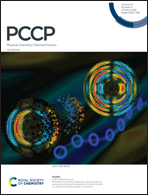Promising application of a SiC2/C3B heterostructure as a new platform for lithium-ion batteries†
Abstract
Constructing heterostructures via the van der Waals coupling effect has provided an effective method for developing novel electrode materials. In this work, based on the first-principles calculation method, we proposed to construct a hexagonal SiC2/C3B heterostructure and confirmed its stability by analyzing its structural properties. Meanwhile, the electrochemical performances of the SiC2/C3B heterostructure as a new platform for lithium-ion batteries were evaluated. The calculated results illustrate that the pristine SiC2/C3B heterostructure is a semiconductor with a small bandgap of 0.15 eV and the lithiated heterostructure exhibits metallic properties which ensure superior electrical conductivity for fast electron transfer. Moreover, the low diffusion barriers of the heterostructure are acceptable to guarantee a high-rate performance for the batteries. Compared with the anode properties of isolated SiC2 and C3B monolayers, an enhancement of the storage capacity of Li ions on the SiC2/C3B heterostructure is observed, which could reach up to 1489.72 mA h g−1. In addition, the ab initio molecular dynamics simulations reveal that the SiC2/C3B heterostructure could maintain excellent structural stability during the lithiation processes even at a temperature of 350 K. All these encouraging results show that the SiC2/C3B heterostructure has fascinating potential to be an advanced platform for lithium-ion batteries.



 Please wait while we load your content...
Please wait while we load your content...